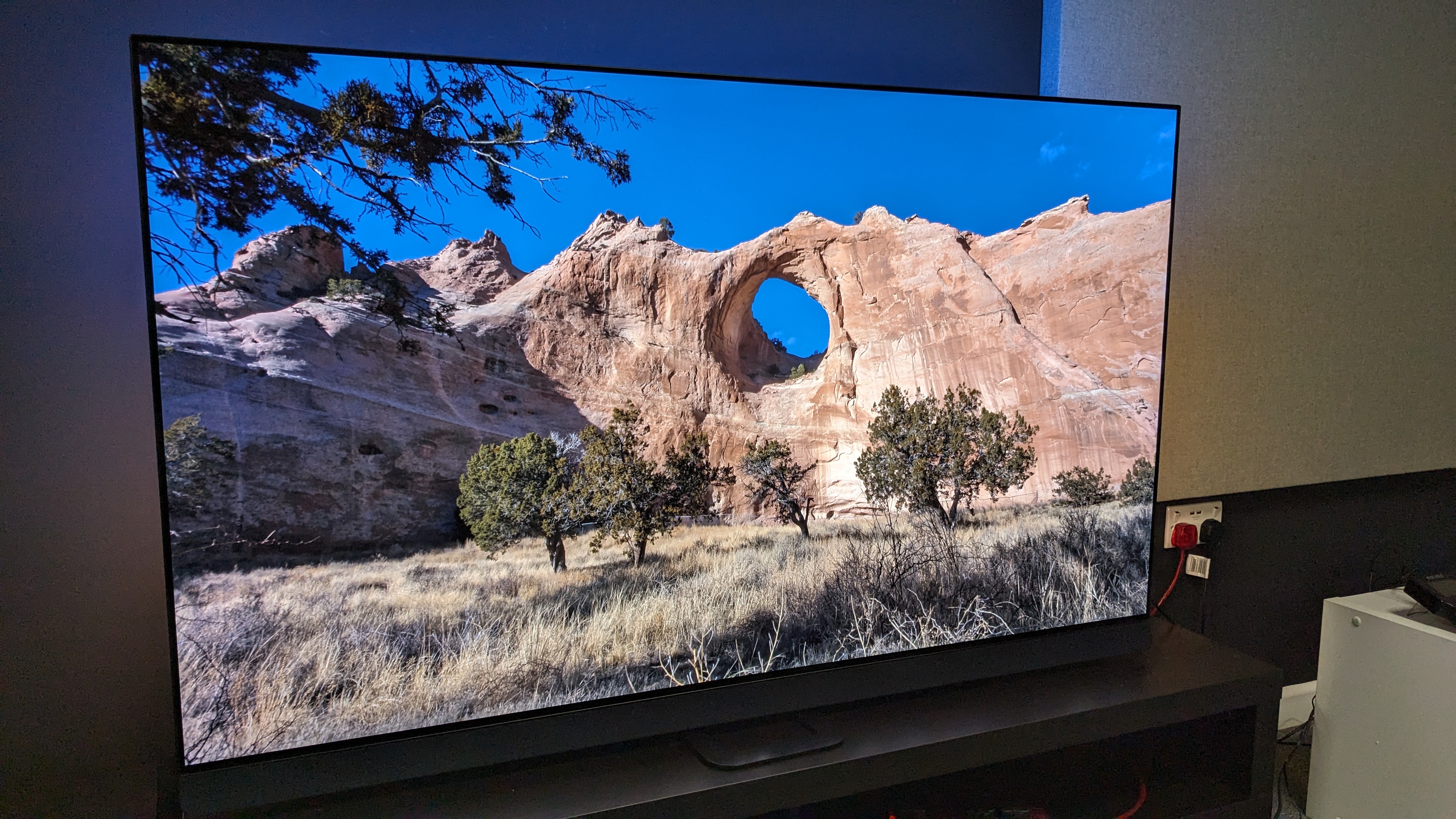
Philips OLED908 review: Two minute review
The Philips OLED908 is the company’s flagship OLED TV from 2023, and one that features an OLED EX panel and Micro Lens Array (MLA) technology. It also comes with Philips’ Ambilight feature, which adds to the movie-watching experience by projecting lights onto the wall behind the TV and can also reduce eye strain.
The OLED908 is priced midway between its closest rivals, the LG G3 and Panasonic MZ2000, both MLA OLED TVs. For instance, the 65-inch model that I tested is available for £2,499, (though we have seen it for £2,099 at some retailers) while the G3 and MZ2000 are priced at £1,999 and £2,999, respectively.
Picture quality is excellent on the OLED908, which has bold colours, deep black levels with accurate dark tones and true-to-life textures. HDR is its strongest point, but SDR upscaling is also good. The OLED908’s picture may not top the Panasonic MZ2000, but it’s still up there with some of the best TVs on the market.
With an external soundbar to aid its room-filling potential, the OLED908’s audio quality is great. Clear dialogue and hefty bass blend nicely with solid surround sound, though again beat the MZ2000 when it comes to Dolby Atmos effects. Still, for those who want to avoid buying a soundbar, the OLED908’s speakers will more than suffice.
With gaming features including VRR, Dolby Vision gaming and 4K 120Hz, the Philips OLED908 is packed with gaming features, with a smooth quality to fast-paced FPS games that delivers the level of intensity gamers look for. Sadly, it comes with only two HDMI 2.1 ports, but that is the one negative on an otherwise fantastic gaming TV.
Design is another area where the OLED908 shines, thanks to its Ambilight feature, but even if you’re not a fan of Ambilight, it’s a sleek, premium-looking TV. Its minimalist stand may not be as solid as the one on the step-down Philips OLED808's, but it still has impressive build quality. Philips’ supplied remote is also one of the best I’ve seen.
Google TV is the OLED908’s smart TV platform and whilst functional and filled with settings to tweak, it doesn’t feel as smooth as LG’s webOS or as clean and simple as Roku TV. It does offer plenty of customisation and recommendation options, however, but is let down by a lack of Freeview Play and compatible apps such as BBC iPlayer and ITVX.
In terms of value, the OLED908 is priced evenly with its competition and fairly for the features it provides. There is, of course, the step-down option of the Philips OLED808, which offers a lot of the same features for nearly £500 less in the 65-inch size , but the OLED908 gives you the full premium experience.
The Philips OLED908 has a sublime picture, great built-in audio, brilliant gaming performance and a stunning design backed by its spectacular Ambilight feature. It's easily one of the best OLED TVs available. The Panasonic MZ2000 may outperform it in a few areas, but with that model priced nearly £500-900 higher, the Philips OLED908 gives you better bang for your buck.
Philips OLED908 review: Prices and release date
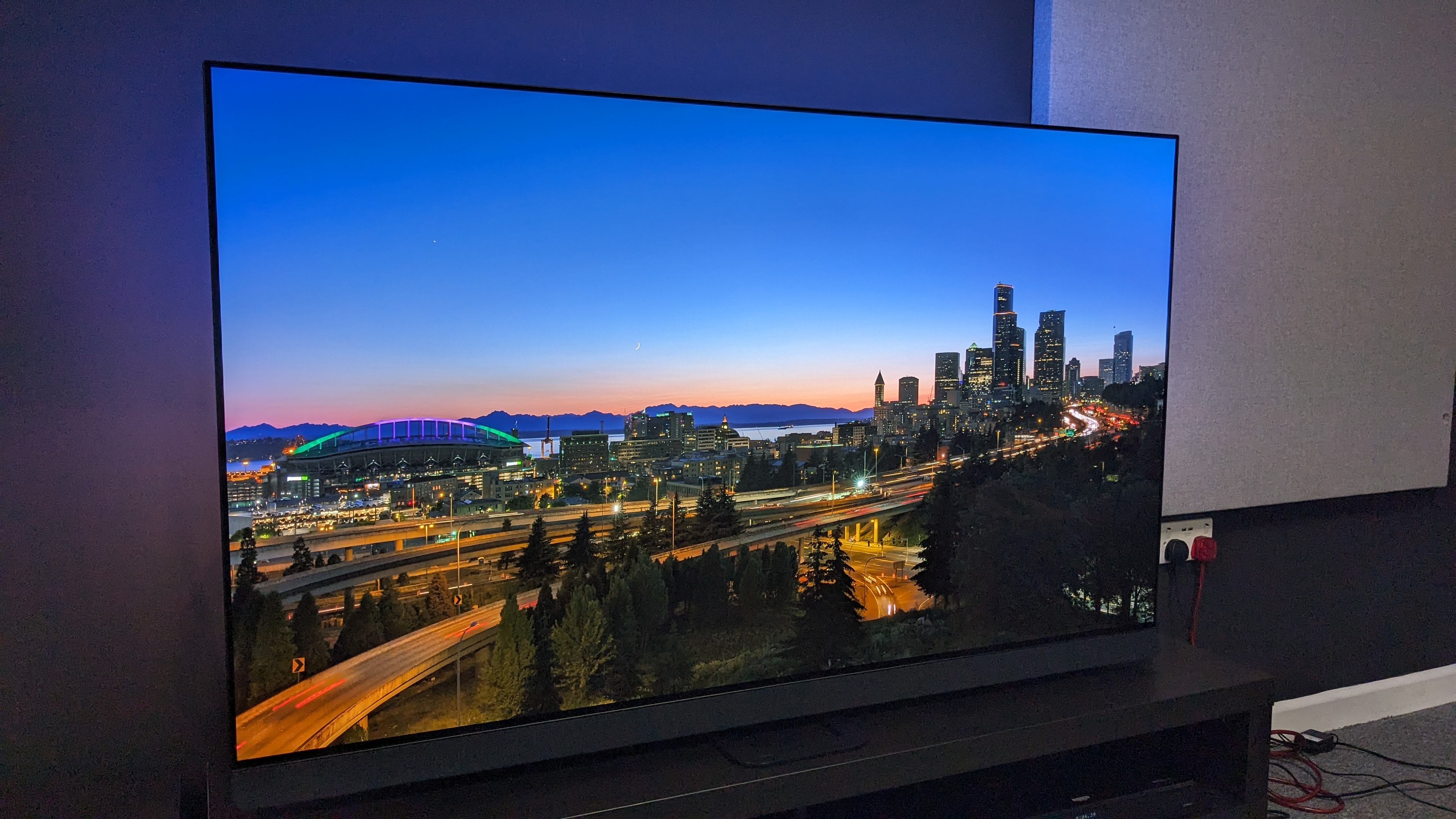
- Released November 2023
- From £1,999 for 55-inch
- Up to £4,199 for 77-inch
The Philips OLED908, the company’s flagship 2023 OLED TV (there is no OLED937 equivalent)was finally released in November 2023 after major delays. At the time of release, the 55-inch model was priced at £1,999, the 65-inch at £2,499 and the 77-inch at £4.199. Those prices are similar to the LG G3, one of the OLED908’s closest rivals, at release.
At this writing, some retailers still have these prices, but we have seen the 55-inch Philips OLED908 available for £1,599, the 65-inch at £2,099 and the 77-inch priced at £3,499, so do keep an eye out for these prices.
Philips OLED908 review: Specs
Philips OLED908 review: Benchmark results
Philips OLED908 review: Features
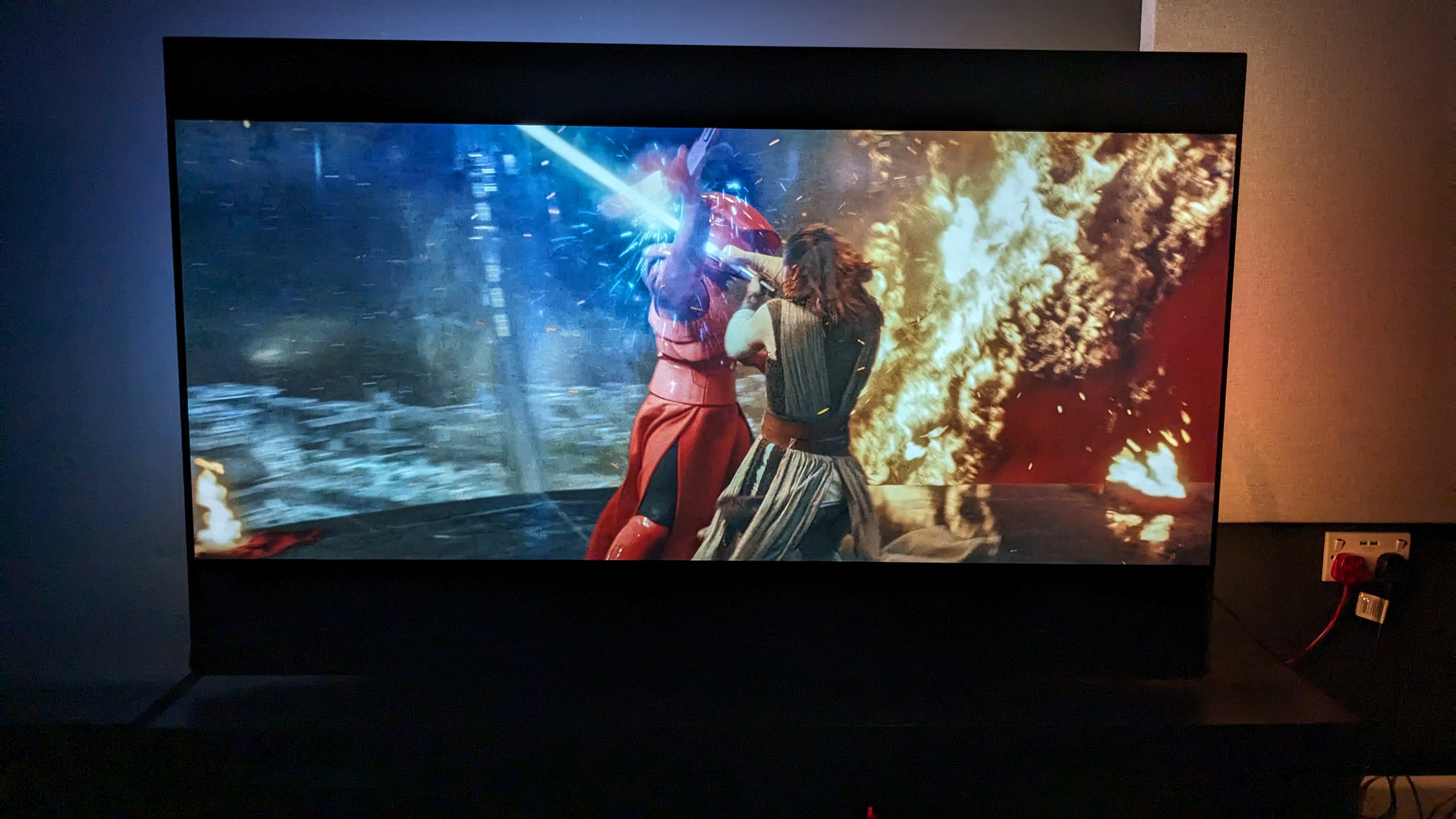
- 3-sided Ambilight
- OLED EX panel with MLA tech
- Audio by Bowers & Wilkins
The OLED908 comes in all available screen sizes with an OLED EX panel and Micro Lens Array (MLA) tech for increased brightness over conventional OLED (W-OLED) screens such as the LG B3.\ HDR is well covered on the OLED908, with Dolby Vision, HDR10+ Adaptive, HDR10 and HLG formats all supported. The OLED908 also features IMAX Enhanced and Filmmaker Mode presets.
Ambilight continues to be Philips’ standout feature across its TVs. This adds an extra level of immersion compared to other TVs, by enabling you to display colors onto a wall located behind the set.lighting can be configured for a variety of styles and moods, such as following action on screen and ambient lighting, and it can also be turned off.
The OLED908’s built-in speaker system consists of 3.1 channels totalling 80W of power and is tuned by Bowers & Wilkins. Located at the bottom of the screen, the fabric-finished speaker array sits as an external ‘soundbar’ similar to the one found in the Panasonic MZ2000, and allows for more direct sound. The OLED908 supports Dolby Atmos and DTS:X formats and is compatible with DTS Play-Fi wireless speakers.
A healthy suite of gaming features are provided on the ,OLED908, including120Hz refresh rate, VRR, AMD Freesync Premium, Nvidia G-Sync, ALLM and Dolby Vision gaming support. These features are only supported on two HDMI ports, however, unlike TVs from Samsung and LG which carry support across four HDMI ports. There is also a Game Mode to optimise settings for gaming. This feels fiddly compared to the Game Modes on Panasonic and LG TVs, although it does feature customisable options such as crosshair,.
Google TV is the OLED908’s smart TV platform, with apps such as Netflix, Prime Video, Disney Plus and more as expected. However, it is important to note that it does not support Freeview Play or any of its apps including BBC iPlayer, ITVX and Channel 4. If you want these apps, you will need to plug in one of the best streaming devices such as an Amazon Fire TV Stick or Roku Stick.
- Features score: 4.5 / 5
Philips OLED908 review: Picture quality
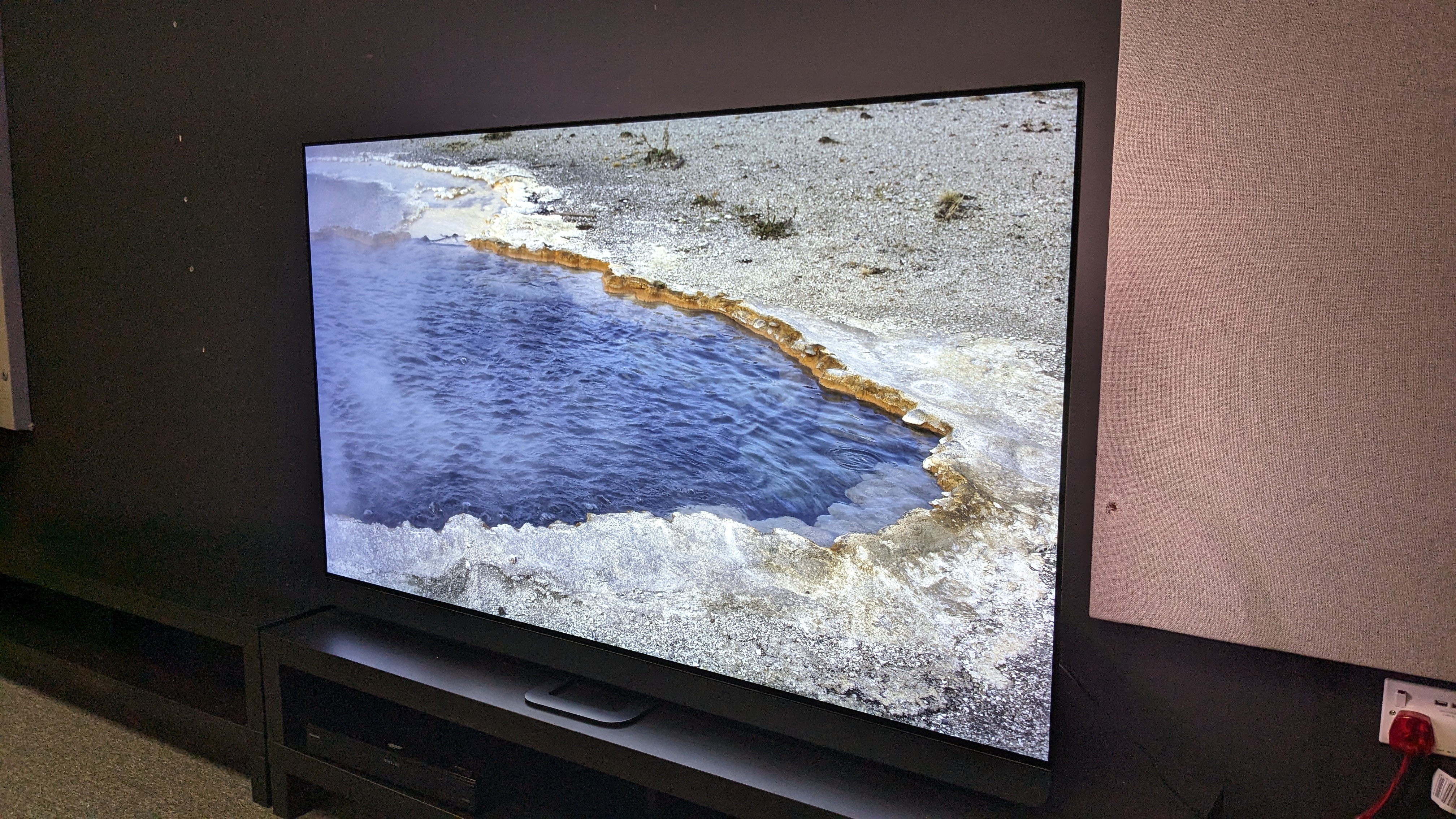
- Superb colours
- True-to-life textures
- Strong contrast
The Philips OLED908 uses an OLED EX panel and both MLA and heat sink technology to boost brightness similar to the LG G3 and Panasonic MZ2000, which are flagship OLEDs for their respective brands .
Philips claims that the OLED908 has a peak brightness of 2,100 nits (it is unclear what size window pattern this was measured on or what picture mode was active) which would surpass other OLEDs like Samsung’s flagship S95C and make it almost as bright as mini-LED TVs such as the Samsung QN90C.
Using Filmmaker mode,the OLED908’s most accurate picture preset during testing, I measured peak HDR brightness at 1,361 nits on a 10% window. Measured on a 2% window (brands often use 3% window sizes for quoted figures) using the ‘Personal’ picture mode (the closest equivalent to Standard mode out of the box, and one that gave lower-resolution and SDR sources a bit more brightness) peak brightness was much closer to the quoted figure of 2,100 nits at 1,853 nits.
Using a 100% window to measure full-screen HDR brightness in Filmmaker Mode, the Philips OLED908 yielded a result of 246 nits, putting it higher than the LG G3’s 219 nits but below the Panasonic MZ2000’s 290 nits.
Starting with SDR sources, a mixture of both lower-resolution and HD pictures, the Philips OLED908’s upscaling was effective. HD broadcast TV shows looked clear, with added sharpness as expected, and while textures on lower-resolution TV shows were fuzzy, the upscaling made the picture watchable. Using the Amazing Spider-Man DVD played on a Panasonic DP-UB820 4K Blu-ray player to further test upscaling, the OLED908 breathed extra colour and life into the lower-resolution image and sharpened some of the slightly muddier textures.
Moving onto 4K sources, I first streamed Star Wars: The Last Jedi on Disney Plus in Dolby Vision to test colours. Using the throne room fight scene, which has a lot of vibrant reds, the OLED908 displayed the red hues brilliantly, rendering them with plenty of dynamic punch without being too overblown. Lightsabers also dazzled, showcasing the OLED908’s prowess with HDR highlights.
Philips claims the OLED908 has a 99% DCI-P3 (the colour space used to master 4K Blu-ray and digital cinema releases) colour gamut coverage and when I measured both BT.2020 and DCI-P3 coverage using Portrait Displays’ Calman software, the OLED908 gave results of 72.8% and 97.5%, respectively–still an excellent result. It is worth noting, however, that the step-down OLED808, did achieve Philips’ claimed figure with a DCI-P3 result of 99.5%.
Moving onto 4K Blu-ray, I next used The Batman to test the OLED908’s black levels, contrast and shadow detail. This is a particularly challenging movie, as it was mastered at 400 nits as opposed to the usual 1,000 nits, and the OLED908 did an excellent job with the dark, gritty picture. During the subway fight scene, contrast was well-balanced, with deep, accurate black levels in dark-toned areas of the screen, but with enough light to keep important details such as faces and the surrounding city lights visible. Shadow detail was also superb, and contrast was spectacular.
When testing the OLED908’s grayscale, its Delta-E values (the margin of error between the test pattern and what’s shown on screen) averaged out to 4.3 (we look for a result below 3). However, I discovered a setting for Light Boost in Filmmaker Mode, and when this was turned off (from the default Medium), grayscale accuracy was 3.6, which is an improvement.
To test motion and textures, I used Top Gun: Maverick. After some viewing, I discovered that Filmmaker Mode had motion processing settings turned on, which is unusual for that mode. After turning them off, motion took on a more natural appearance whilst still keeping judder to a minimum and fast panning shots of jets were well handled. Textures and landscapes were also incredibly refined and detailed, appearing true-to-life.
Demo footage on the Spears & Munsil UHD Benchmark 4K Blu-ray, which over its 7-minute runtime tests all elements of picture quality, showcased how good the OLED908’s picture was. Colours, contrast, textures, black levels and more were superb, with the highlights including a detailed, vibrant parrot and a bright cityscape against a ‘true’ black sky.
- Picture quality score: 4.5 / 5
Philips OLED908 review: Audio quality
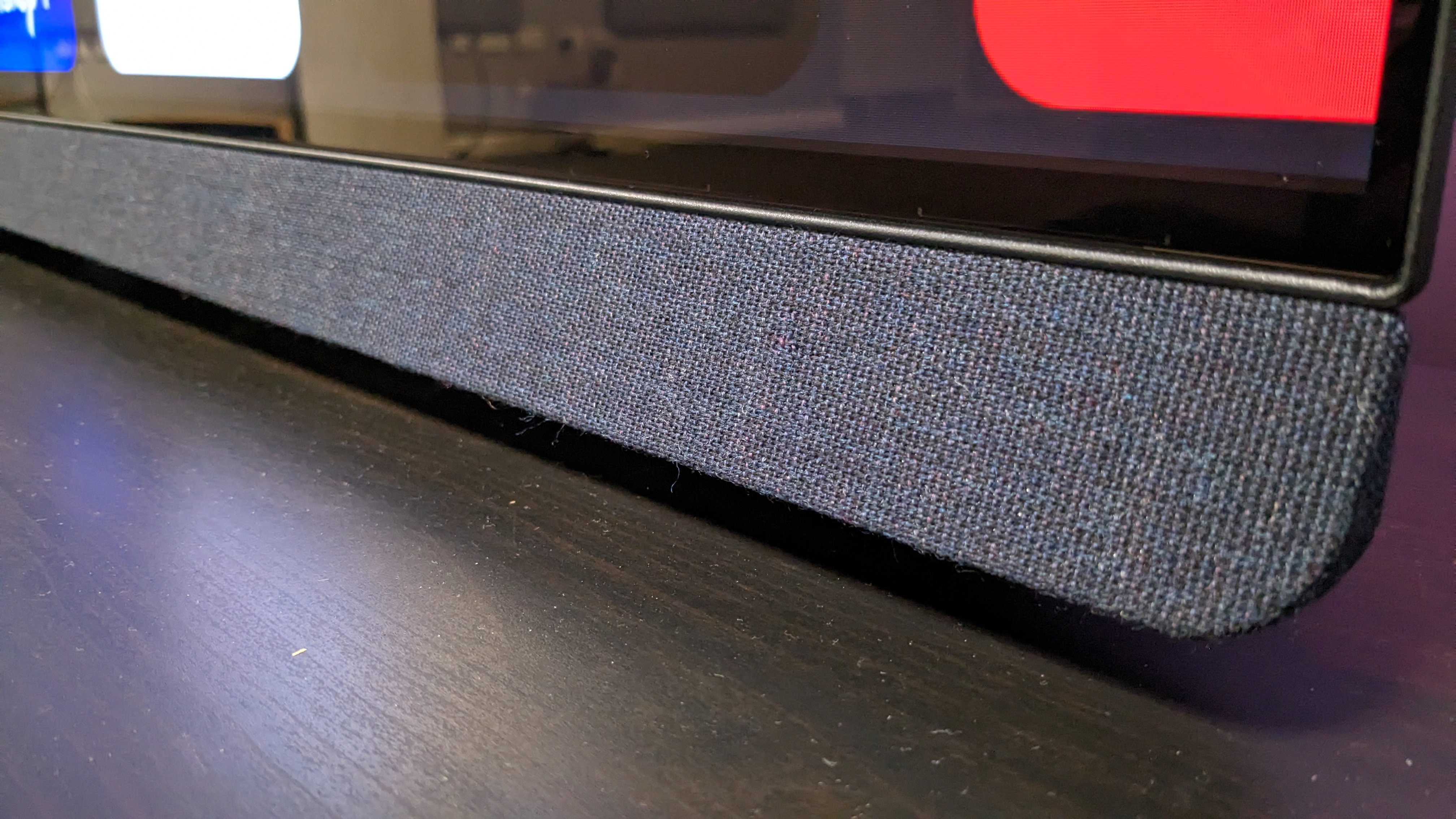
- Clear dialogue
- Good balance of bass, mids and trebles
- Wide soundstage
In similar style to the Panasonic MZ2000, the OLED908 uses an external soundbar as part of its speaker configuration, which consists of 3.1 channels. I found the audio quality on the step-down Philips OLED808 to be brilliant and the OLED 908 builds on this even further.
Using the Batmobile chase scene in The Batman, the OLED908’s bass was weighty with plenty of power, capturing the deep rumble of the Batmobile’s engine even at lower volumes. Dialogue was clear even in scenes where voices were hushed or whispered and the eerie, tense score didn’t overpower the rest of the mix. The OLED908 is Dolby Atmos-compatible and although it has a wide soundstage, Atmos effects such as rain weren’t as prevalent as they were on the Panasonic MZ2000.
Top Gun: Maverick was a similar story as The Batman, with the OLED908 delivering plenty of rumble from jet engines and room-filling power as they roared across the screen. The sound was also well-connected to the action on screen, and felt responsive and tightly controlled. Speech, again, was clear, even at lower volumes.
Whilst the OLED908 won’t beat the best soundbars available, its built-in audio is no slouch. For those looking to avoid buying a soundbar, the Philips OLED908 is one of the best TVs for sound you can get.
- Audio quality score: 4.5 / 5
Philips OLED908 review: Design
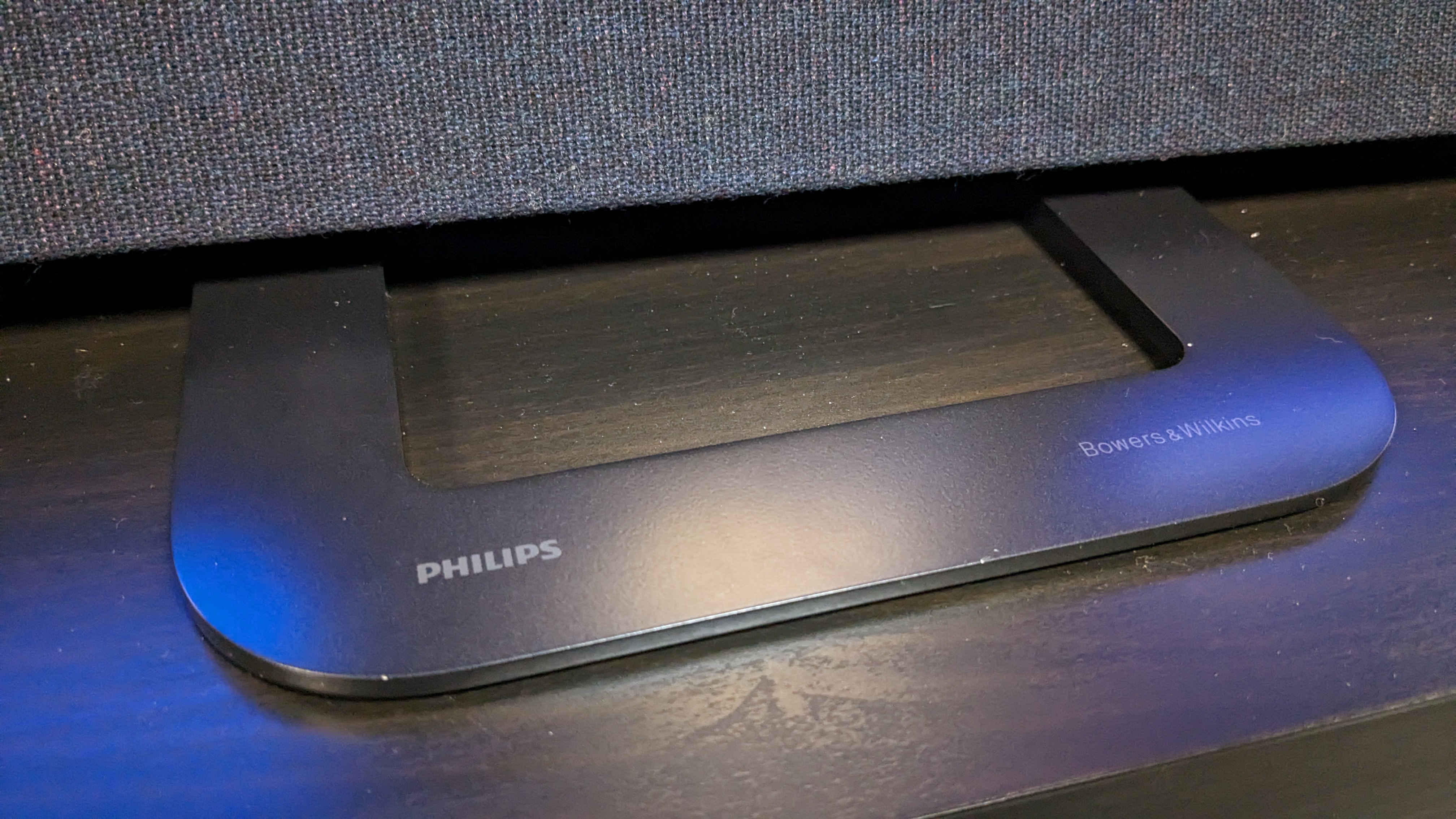
- Immersive, vivid Ambilight
- Supplied remote feels premium
- Stand not quite as good as Philips OLED808
Ambilight continues to be Philips’ crowning design feature and the OLED908 is no exception. It may not feature the four-sided Ambilight of previous generation Philips TVs, but its 3-sided Ambilight is still vivid and colourful and delivers a striking added layer to the movie-watching experience. With Ambilight set to ‘Vivid’, colours project onto the wall and follow the action on screen with precision and here are options to follow audio or display colours with different moods and intensities.
Aside from Ambilight, the OLED908 is a sleek TV with a slim bezel and trim frame. It’s deeper than OLED sets from LG and Samsung, but this is to be expected as it houses a large rear speaker and the Ambilight lighting. The supplied stand has a minimalist look, with a central, curved front that also rotates for easy manoeuvrability within a room. I found the OLED808’s central stand to be more appealing and solid when I reviewed it, but the OLED908’s stand is still perfectly fine.
The OLED908’s supplied remote is simply one of the best I’ve seen - this is what OLED TV remotes should look like. With a glossy black metal design, it feels both weighty and premium. It lights up for easy use in darker environments when interacted with, and is rechargeable via USB-C.
- Design score: 5/5
Philips OLED908 review: Smart TV and menus
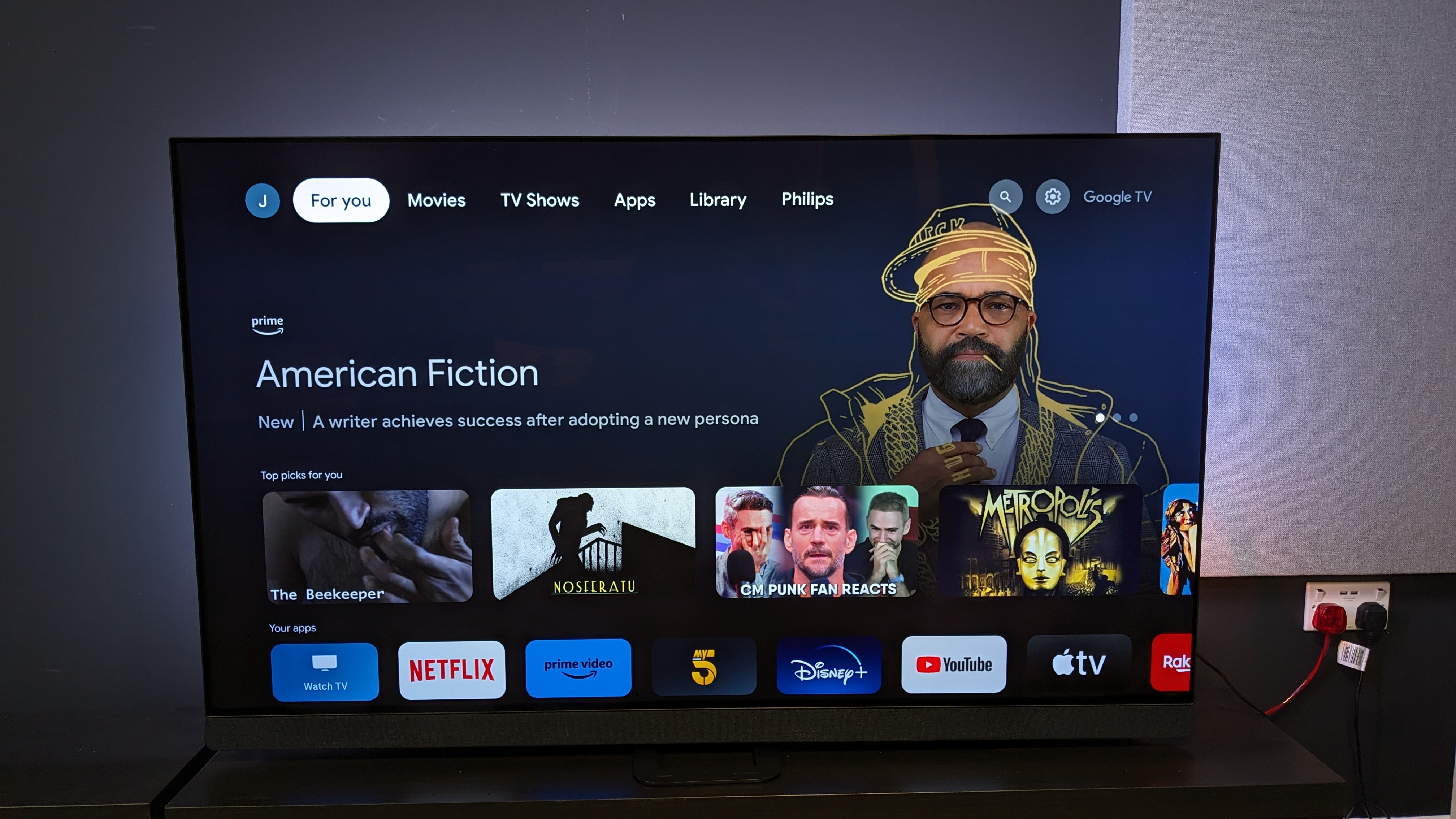
- Google TV
- Many settings to customise picture and sound
- No Freeview Play apps
The OLED908 uses the popular Google TV as its smart TV platform. This taps your viewing history across various apps along with your Google account to make the TV show and movie recommendations, showing them on the main trending content. Google TV also has an apps-only mode to give it a Roku TV-like appearance for those looking for less screen clutter.
There are plenty of preset modes for picture and audio and plenty of settings to customise the picture to suit your taste, including a ‘Personal’ Picture mode which will remember your specific settings. One thing that I found slightly frustrating was that when altering picture settings such as contrast or brightness, the menu obscured the picture, which made navigation a bit cumbersome.
One negative I found when I tested the Philips OLED808 was the lack of a quick menu as found on LG TVs and there’s a similar story with the OLED908. A single press of the Settings button calls up a menu with Screensaver, Picture, Wi-Fi and other options but none for Sound. It’s a bit of an improvement, but I had hoped for a more complete one .
The OLED908 does have access to a lot of the major streaming apps including Netflix, Disney Plus and Prime Video, but it is important to note that it doesn’t have access to Freeview Play or any associated apps such as ITVX and BBC iPlayer, which some users may find disappointing.
- Smart TV & menus score: 4/5
Philips OLED908 review: Gaming

- Brilliant gaming performance
- Stacks of gaming features for consoles
- Only two HDMI 2.1 ports
The Philips OLED908 has plenty of gaming features that will keep PS5 and Xbox Series X owners happy, including 4K 120Hz, Dolby Vision Gaming, VRR support including AMD Freesync Premium and Nvidia G-Sync, and ALLM and HGiG.
When it comes to gaming performance, the Philips OLED908 ranks with some of the best gaming TVs. Playing Battlefield V, it handled graphically intense battle scenes with ease, as scanning the environment and quickly targeting enemies was smooth and seamless. Interestingly, in the HDMI inputs section of the OLED908 there are two game modes - Auto Game Mode and Auto Game 120Hz Mode. The former is said to support VRR gaming whilst the latter is said to be best for ‘professional gaming’. Switching between the two, the 120Hz mode felt marginally smoother, but the difference was minimal.
The OLED908’s fantastic picture quality carries over to gaming as well. During an autumnal mission, it was filled with crisp yellows and reds that felt lifelike and accurate - even the muddy terrain and damaged grey buildings had an accurate colour. The surroundings and intricate weapons were also well-defined and detailed.
The TV has a Game Mode and a Game dashboard (which can be activated by holding down the Menu button for a few seconds while in Game picture mode) that is effective and shows information such as frame rate and HDR forma. Philips’ Game Mode also contains adjustable settings such as crosshair, but it lacks the visual punch of similar modes on LG and Panasonic TVs.
- Gaming score: 4.5/5
Philips OLED908 review: Value
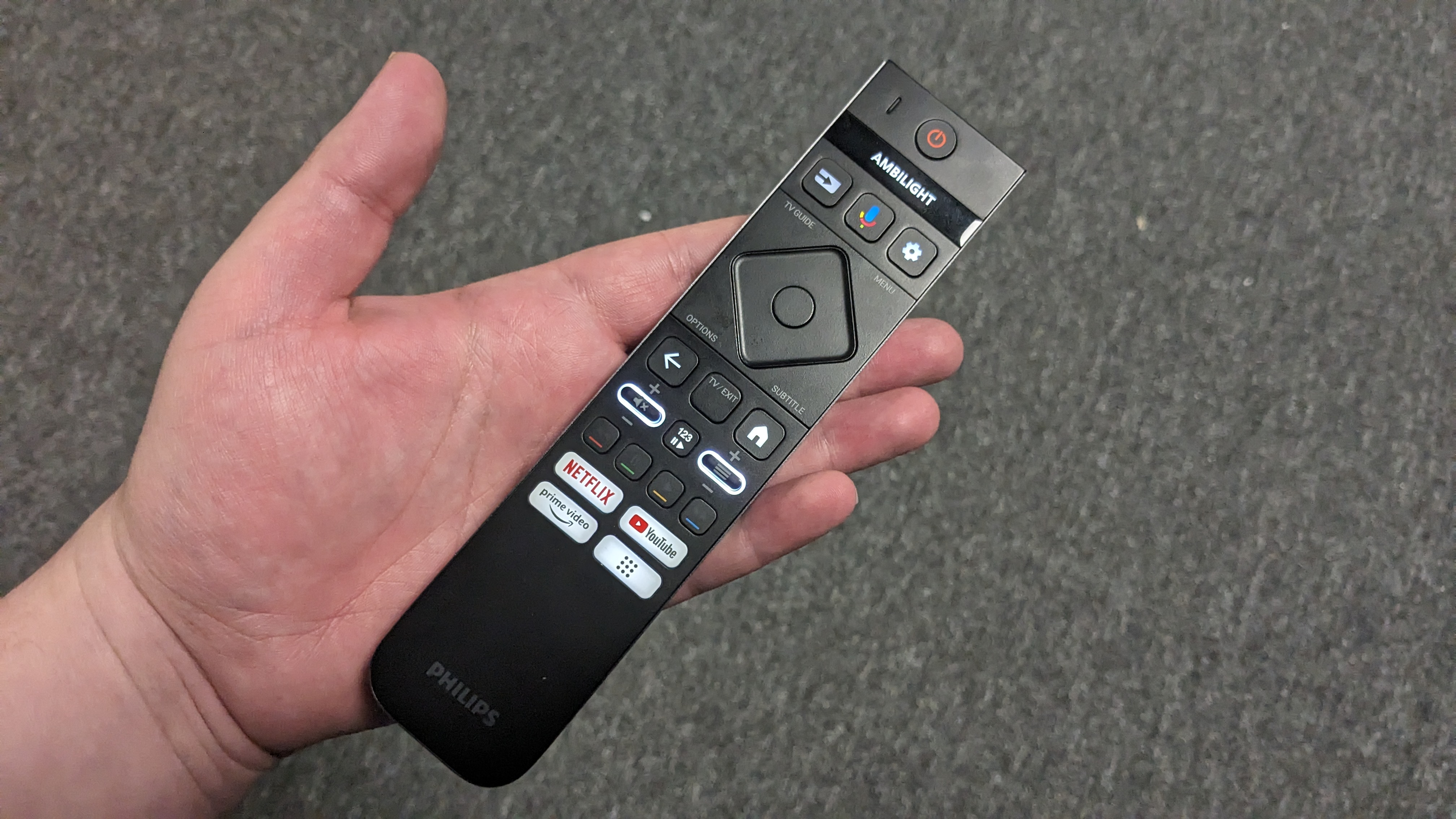
- Competitively priced
- Great features for the price
- Ambilight is a unique selling point
As the Philips OLED908 was released late, it has a more expensive standard price than its rivals, but as stated above is available at a discounted price at Richer Sounds. For the cost, you are getting the unique Ambilight feature as well as similar picture and audio quality to the LG G3 and Panasonic MZ2000.
For the 65-inch model I used for testing and review, you’ll be paying £2,499 standard price or £2,099 on offer. This puts it in line with the 65-inch LG G3, which is priced at roughly £1,999 at the time of writing, and less than the 65-inch Panasonic MZ2000. which is priced at £2,999.
The step-down Philips OLED808 offers a lot of similar features, with the 65-inch available from most retailers for £1,599, though you’ll be missing out on the OLED908’s MLA tech and increased brightness.
- Value score: 4 / 5
Should I buy the Philips OLED908?
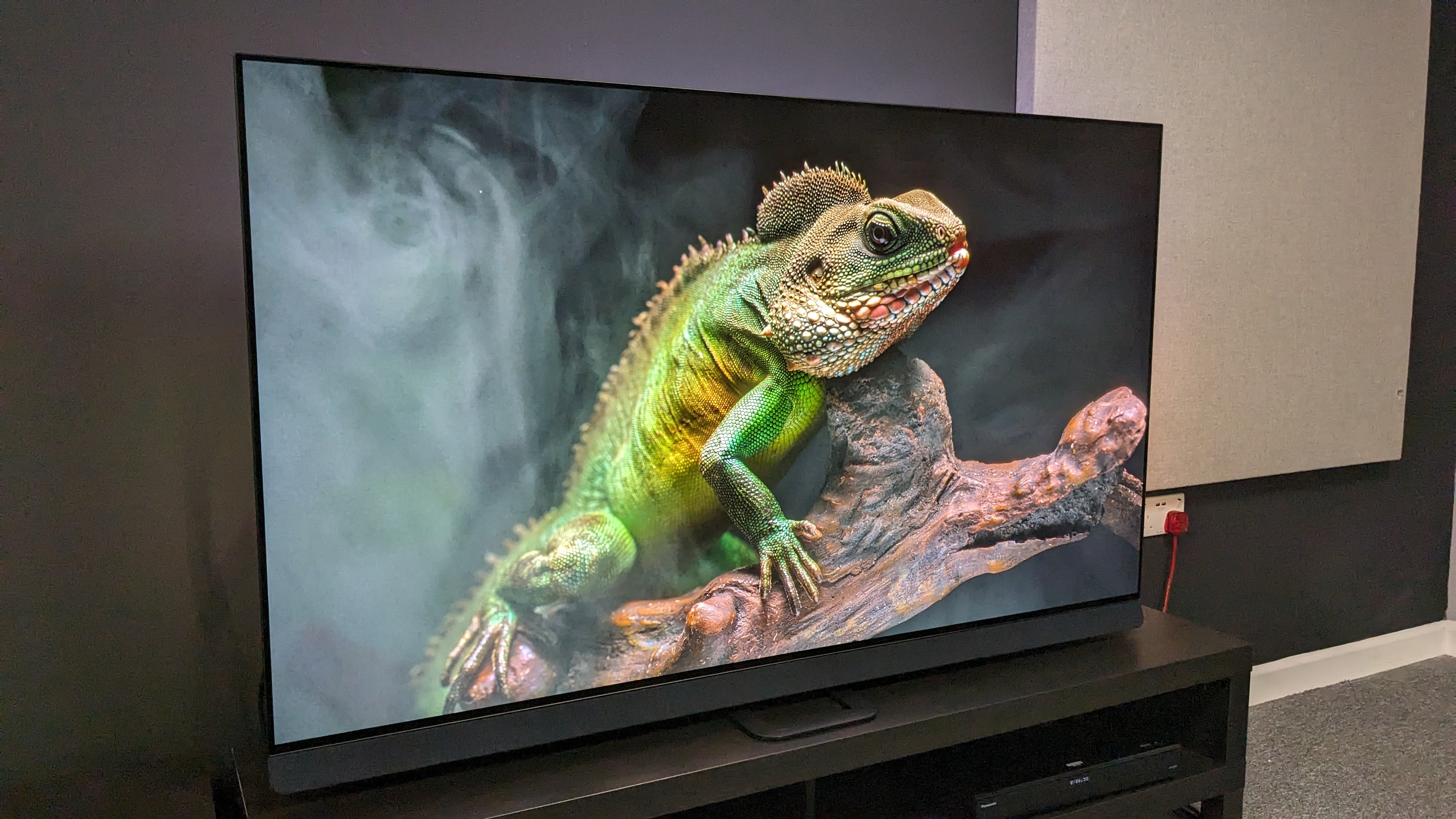
Buy it if...
Don't buy it if...
Philips OLED908 review: Also consider
How I tested the Philips OLED908
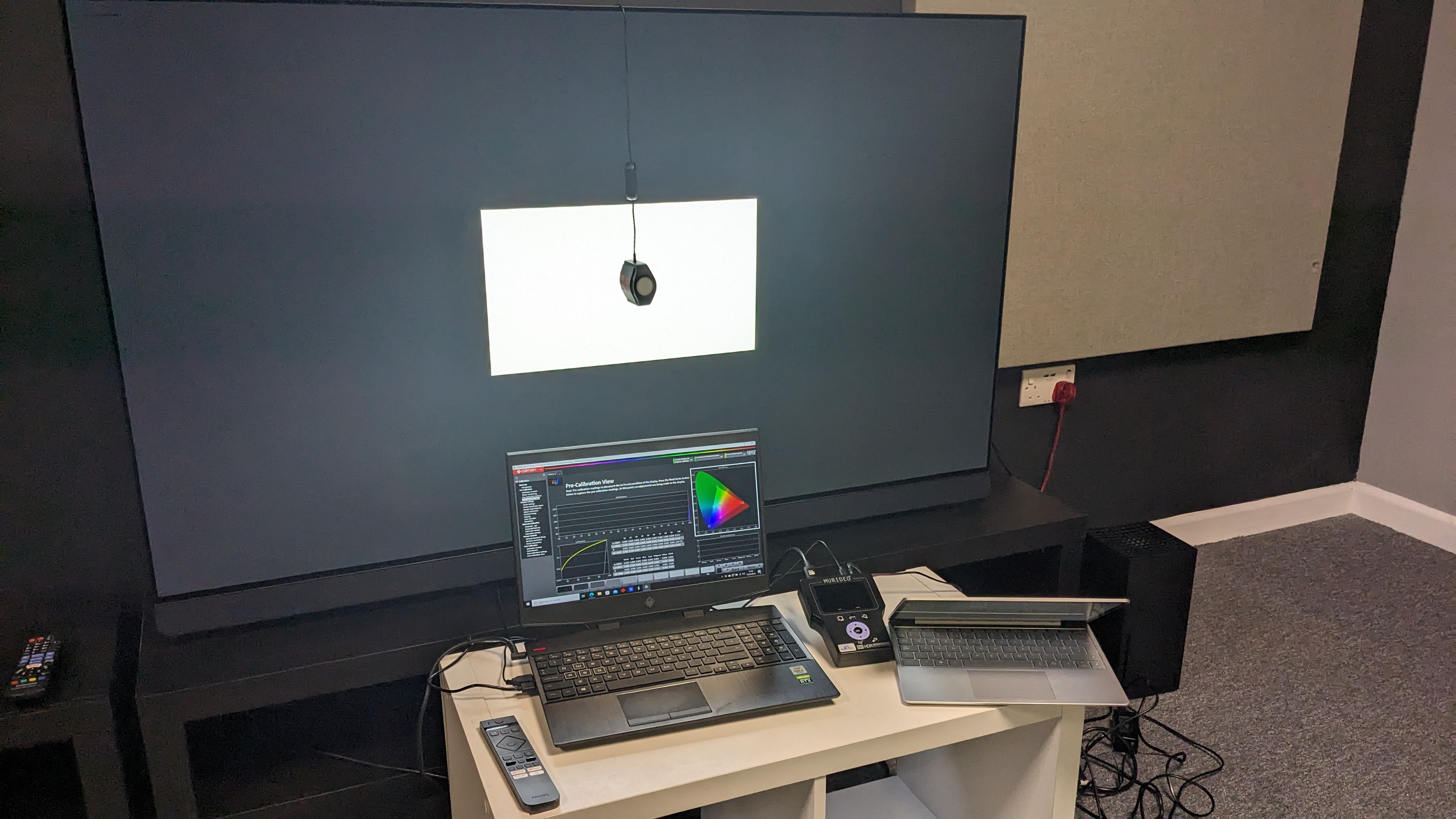
- Tested in light controlled environment
- Objective measurements taken using equipment
- Multiple sources HDR and SDR sources used to test picture
When it comes to how we test TVs at TechRadar, we use a mix of both subjective and objective tests to form our opinions of each TV. For the Philips OLED908, I first started by running in the TV for a couple of days and then after determining its best picture mode, Filmmaker Mode, after cycling through the picture presets, I began my subjective tests.
Using multiple HDR sources, such as 4K Blu-ray, streaming and Dolby Vision, and SDR sources, such as HD and lower-resolution broadcast TV and DVD, I tested the OLED908's picture for colour, contrast, motion, black levels and shadow detail, sharpness, upscaling and more.
I used an Xbox Series X, mainly playing Battlefield V, to test gaming features and performance, looking at smoothness and responsiveness of gameplay and how effective the OLED908's Game Mode was. I also tested the input lag of the OLED908 using the Leo Bodnar 4K HDMI Video Signal Lag Tester.
Moving onto objective testing, I used specialised equipment - a colorimeter and test pattern generator - alongside Portrait Displays' Calman calibration software to record results.
To test the brightness of the OLED908, I took measurements across a variety of different sized white window IRE patterns - from 1% to 100% in bot HDR and SDR. The two most important were 10%, which gives the most realistic idea of peak brightness, and 100% (full-screen), which tells us how a TV handles reflections and what brightness in can sustain over an entire screen - important when viewing sports.
I also tested grayscale and colour accuracy recording the average across its Delta-E values (the margin for error between the test pattern and what's displayed on screen). I then tested the BT.2020 and UHDA-P3 colour gamut coverage in HDR. For all these tests I used Portrait Displays C6 colorimeter and the Murideo Six 8K test pattern generator.
Finally, I also tested the input lag of the OLED908 using the Leo Bodnar 4K HDMI Video Signal Lag Tester.
- First reviewed in March 2024



!["[T]he First and Fifth Amendments Require ICE to Provide Information About the Whereabouts of a Detained Person"](https://images.inkl.com/s3/publisher/cover/212/reason-cover.png?w=600)



